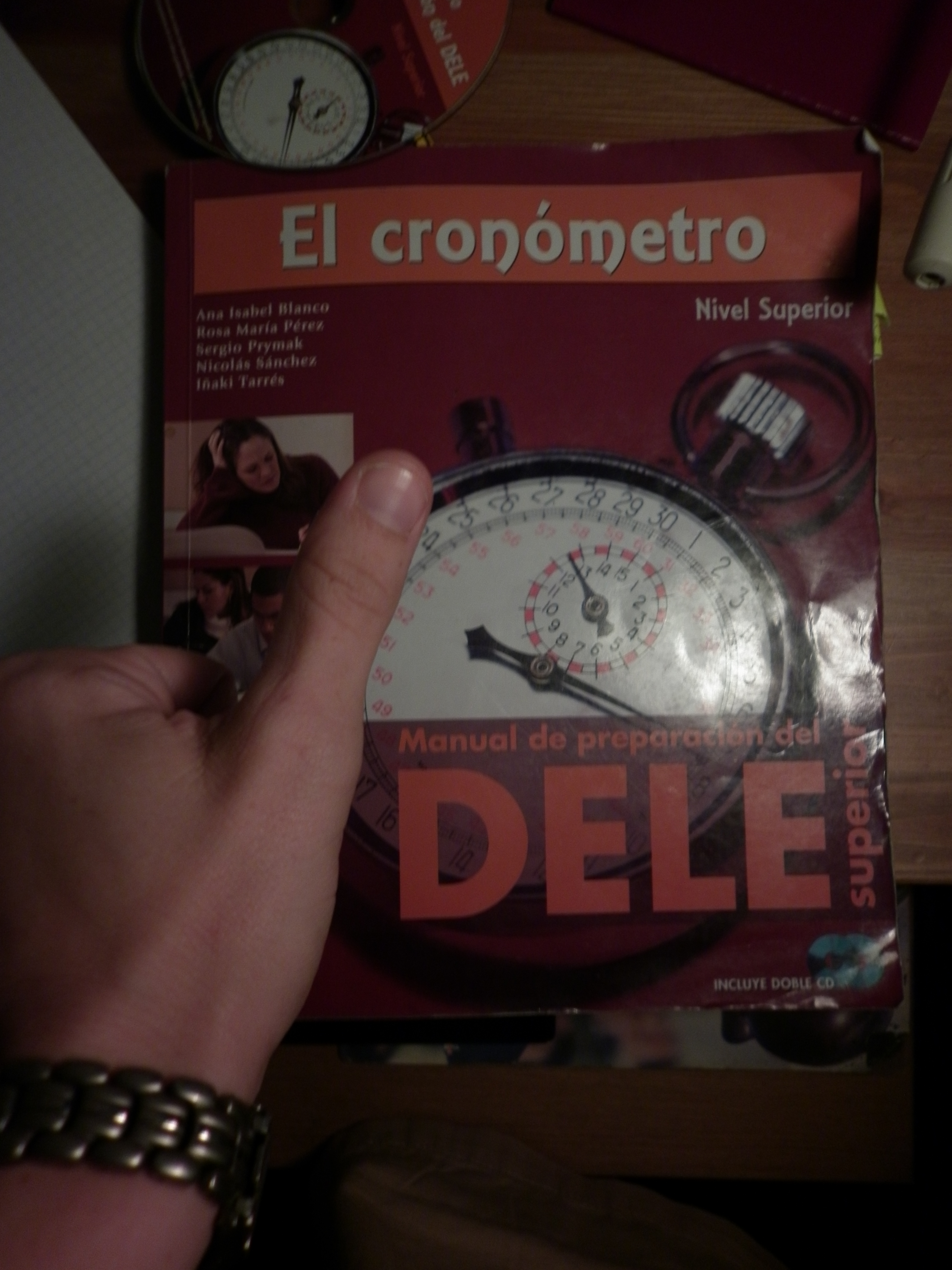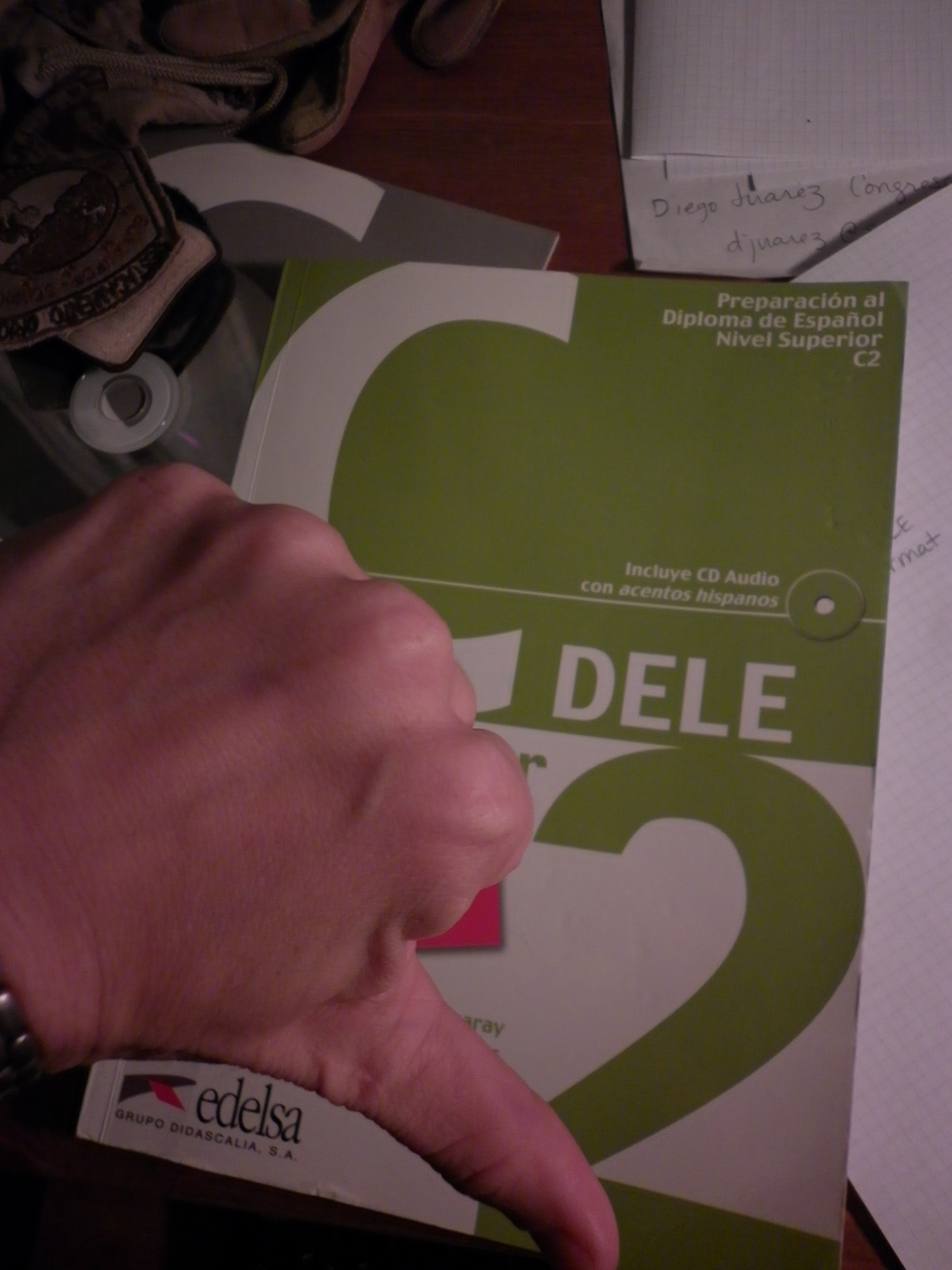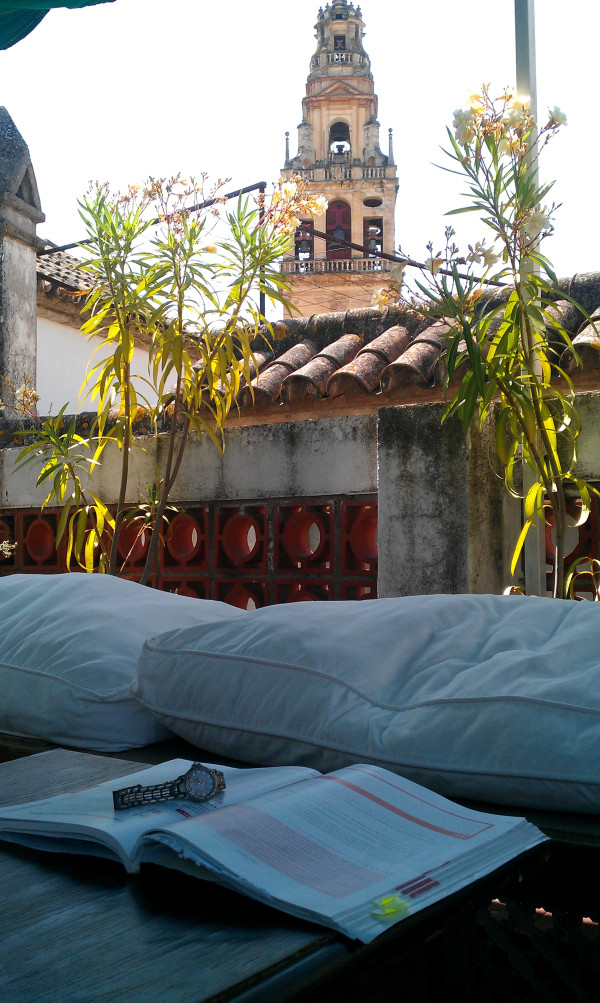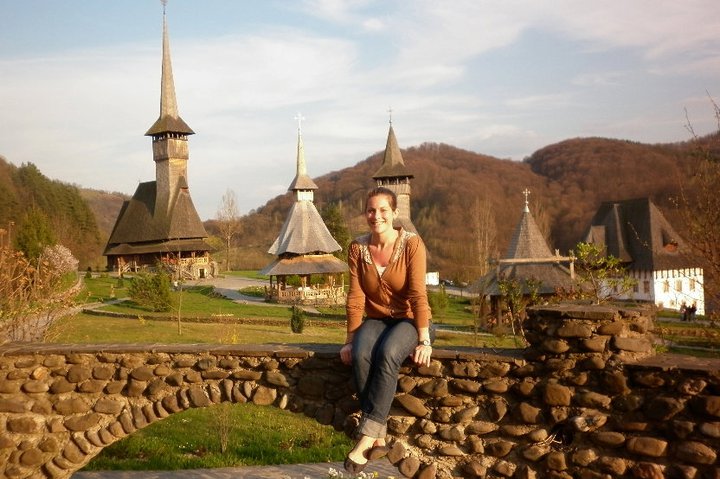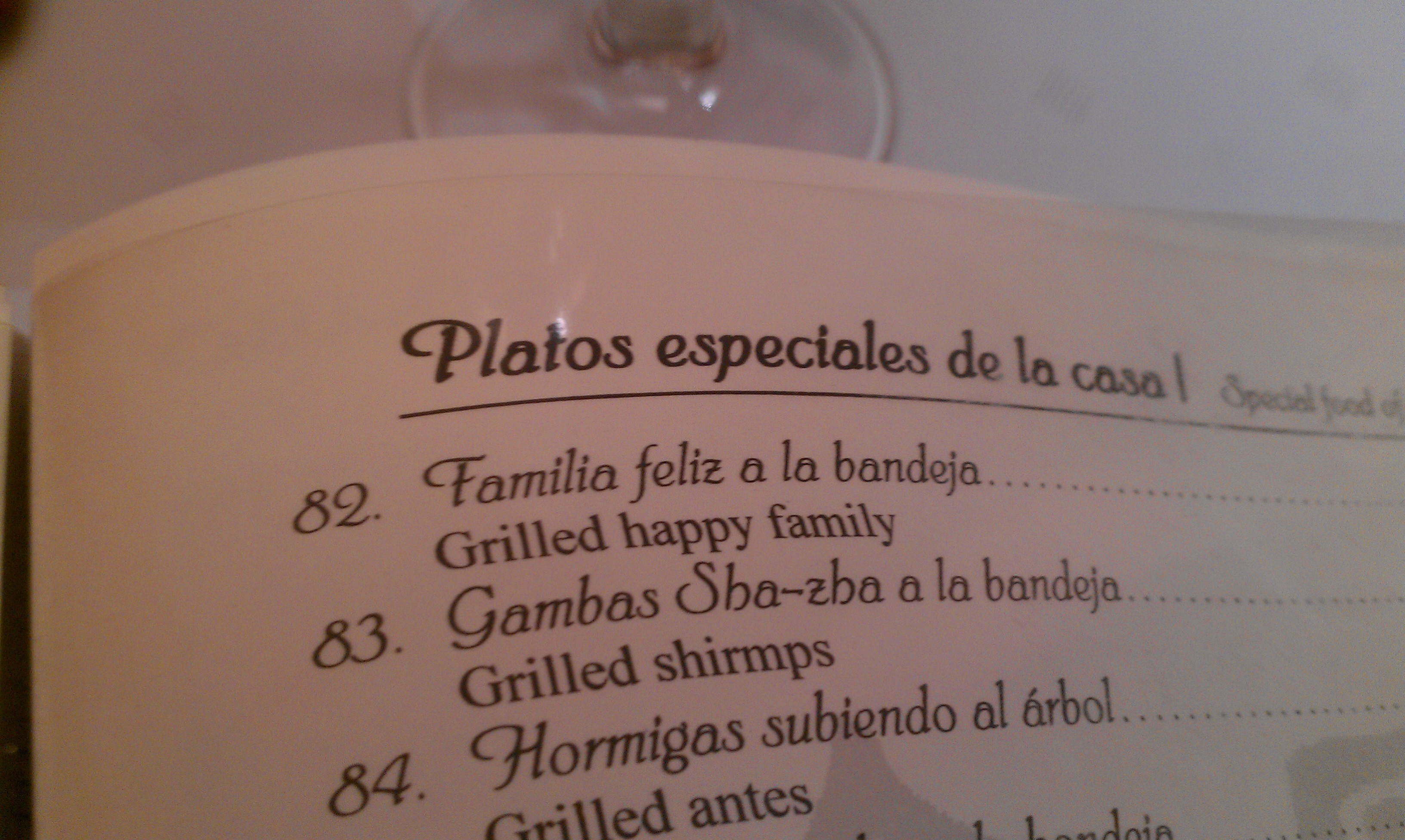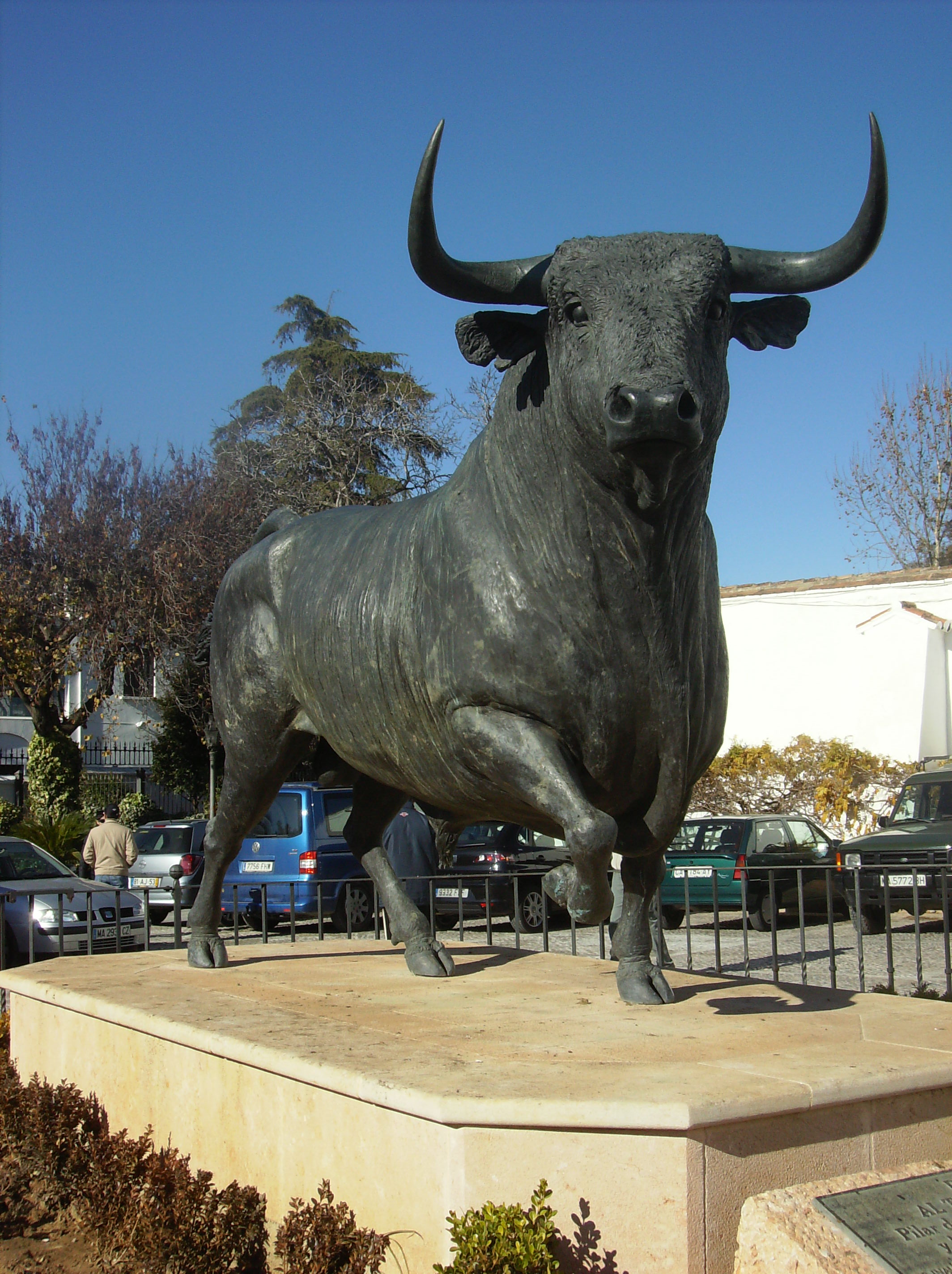Hatched as a plan to find something to do during the cold winter months when the Novio was away in Somalia, I decided to begin studying for the DELE. I didn’t need it for a job, nor a university program. Nay, this overachiever wanted to prove she knew enough Spanish to have a piece of paper proclaiming it.
Famous. Last. Words.
The Diploma de Español como Lengua Extranjera is an internationally recognized exam that probes the level of a non-native speaker who can operate using the language in the various skills of foreign language learning: writing, speaking, reading, listening. It’s comparable, depending on one of six levels of the Marco Común Europeo de Referencia, to the Cambridge and Trinity Exams of English. The exams are supervised by The Instituto Cervantes, a renowned study center from which you can request a free brochure.
Little Miss Smarty Pants thought she could do the C2 Superior Level. After doing some research on the exam’s sponsor, Instituto Cervantes, I marched down to FNAC to buy the prep books, El Cronómetro and the Edelsa C2. I ended up getting only the first, mesmerized by the stopwatch (hence the title) and nervous when I cracked open the book to see just black, white and maroon and no pictures, just tiny little stopwatches next to the words “pon el reloj.”
The May examination date rolled around, and between Holy Week, Feria, and visits from not one but four friends…well, I forgot to sign up. No pasa nada, I thought, I’ll just study during those rainy afternoons at camp and then that month I’m home doing nothing. I toted the book to La Coruña and then to Wheaton, but only cracked it on a long car ride to Kentucky to write out the slang words on cards to study.
My exam is in ten days. At some moments, I feel confident and like test ain’t got nothing on my Spanish-wielding tongue, until I remember that I also have to know how to write and interpret well in a language.
After finally hitting my stride (and saying adiós to my social life), here are some Do’s and Don’ts of studying for the DELE.
DO buy the right materials
After starting your initial search to find out more about the DELE on the Instituto Cervantes website, it should come as no surprise that there are books made especially for the exam, much like the standard GRE or LSAT books. To help get you started, you can ask for an informational guide from the Instituto Cervantes.
The book recommended by the FEDELE in Seville was the Cronómetro. I prefer this book because it not only has tons of practice session, but it also helps you find the testing method most suited for you. When doing the reading comprehension, is it easier for you to read first, then tackle the three questions, or is it better to read the questions first to know what you’re looking for? It also has a better description of what to expect from each section in the exam. I bought it at FNAC for around 24€, and the newest edition, all green and white and super bético, was the same price of of Amazon in Spain. Since the format of the C2 has changed this convocotoría, this book is better suited to help you prepare for the new exam.
I also used the Edesla C2, which was really like a series of mini-exams within a different theme (science and technology, arts and ethics, man and his surroundings). What’s more, the Libro de Claves was actually sold separately, so I had to make yet another trip to FNAC and spend an extra 3€. And I peeked because the questions were so incredibly vague. “En el texto se dice”: UM A LOT OF THINGS?!
My pick is definitely the Crom. So go ahead and Pon that Reloj.
DON’T assume you know your level: do the online exam
In Europe, there is a standardized model of foreign language comprehension, known as the Marco Común Europeo de Referencia (MCER) here in Spain. This is an umbrella term, as it refers to the basic competencies a language learning should have in his desired language. the DELE, for the most part, follow the MCER, so the six levels are standard, and you can see them here.
Before going out and buying your prep books, take the shortened version of the exam, available on the Instituto Cervantes Spanish page (click here). I took it once before studying hardcore and scored a C1.4, the highest level of C1, and again just last week and scored a C2.1, the lowest for that level. Additionally, the FEDELE offered to have me come in and take a few practice oral exams, though the woman told me I was a C2 and should consider taking the C2 written, as well.
Looks like I made a good choice in the C1.
DO find a good place to study
My Cronómetro book looks like a tattered old journal – all marked up, the binding half-ripped. Sadly, I have carted the 300-paged monstrosity around to too many places – Córdoba, America, Madrid – and barely even given it a second thought. Every time I think I can study somewhere, I find it’s impossible because of background noise or distractions.
Case in point:
Sure, it was nice sitting outside on a balmy May morning, but the quarterly chimes on the nearby Mezquita made me nervous and more time-conscious than usual. And trying to study on the AVE high-speed train? Please.
I would study as close to the conditions as possible – sitting upright, having a pencil and sharpener handy, plenty of light, and no distractions (even turn your móvil down if you have to! Mine beeps constantly, so I put it in a different room). I often waited to do the listening portions until The Novio was out of the house and didn’t have the TV blaring.
DON’T try and study outdoors, during holidays or when friends are in town.
Did I care cramming one weekend when I had nothing better to do? Of course, but I don’t regret not taking the exam before when I had friends visiting and I wanted to travel to Romania and when the rebujito and Monica’s arte took over at the Real. Be realistic – if you can’t put in the time needed to adequately prepare, don’t pay to do the exam.
DO consider taking a course or having private instruction
Doing simple google search for “cursos DELE” nets hundreds of places to get exam prep, both online and in person. Most are costly (around 300€), but come with the practice book and pautas and tips to doing the exam. I knew I could study for the majority of the test on my own, but considered hiring a Spanish teacher to help me with the writing and speaking part of the exam. In the end, our schedules weren’t compatible, but Eva seemed like a great resource.
The first place to look is the Instituto Cervantes itself in your city, and finally at the various language centers in your city, like CLIC or even universities with international programs. Keep in mind cost, whether or not it’s intensive or not, the success rate of students and if you think it will help you in the long run or not.
I personally thought the people at CLIC in Seville and Cádiz were more than happy to help me prepare by offering free consultations, following up with emails and in turn being an examination center. In addition, the Instituto Cervantes also offers online consultations, practice exams and prep courses.
DON’T freak out about knowing all of those stupid refranes.
Guess what! They’re no longer on the exam! Collective sigh of relief, verdad? Before, the there were up to 12 points to be earned simply by reading a statement with a refrán, or a type of common saying, and choosing one of three options.
For example: Me han dejado asistir de oyente, pero no puedo meter baza en ningún momento.
Well, you say, meter means plenty of things, and Baza is a small town in Granada, and the sentence says you were able to go to a lecture and listen, but surely it had nothing to do with that little village. So, you look at the three choices. A intervenir, B interrumpir, C cooperar. Hmm, no help. I chose B, but it’s actually A. There were eight of those in a 60 minute test that also included text completion and error detection.
Instead, I would focus more on knowing prepositions, por v. para, ser v. estar and the subjunctive tenses more to help you on the writing and speaking sections of the exam. No los estudies, ni a tiros!!
DO practice writing prompts like crazy – even the ones you’d never choose on the actual exam.
I tried to skip them, but I couldn’t. The writing section is a large part of the DELE, consisting of two parts: in the first, you’ll be asked to pick one of two options regarding a formal letter or email. This may be a complaint, a letter to the mayor, an email requesting information, a reclamation of a service…and the list goes on. It’s important to know formal salutions, advanced vocabulary and to include all of the parts asked for in the prompt.
The second part is more personal, and you’ll have to choose between three different prompts. These could be about personal opinions, experiences or anecdotes. The language employed here is much more narrative and you’ll often be asked to describe how you felt when X took place. And it doesn’t hurt to make it related to Latin culture, either.
Keep in mind you’ll have to beat the clock: you have 60 minutes for brainstorming, drafting and re-writing your two pieces of 150-200 words in pen. Practice with your clock ALWAYS, on all of the parts of the exam, but be much more wary during this section. Your pieces should also be clear and use the language you know – it’s advised to make the letter more simple if and always when it’s clearer.
DON’T cram. Make a doable schedule, and stick to it.
My biggest mistake. I would come home so wiped from school, that I often put off studying. Then I had work to do. Then it was someone’s birthday. And, in the spirit of Dude, Where’s My Car, and then and then and then and then…! En fin, I wasted a lot of days where I could have been working through problems and writing prompts and instead had to cram last weekend and barely consume any beer. These last few weeks, I’m doing my best to do one or two practice sessions a night to be able to stay on top of my game but still not stress out.
I learned time management skills when I was like in third grade…what happened to them?
DO practice outside of the book – listening to political debates, brushing up on medical vocabulary, reading hilarious books like El Tesís de Nancy
I realize I live in Spain and have ample opportunities to speak and listen to Spanish, but I have been utilizing all kinds of tools to amplify my vocabulary – even my smart phone! I downloaded an app called Prensa de España, which has newspapers from around Spain in mobile format, found a great English-Spanish dictionary and have been listening to podcasts. The world is my oyster when it comes to finding even MORE ways to sneak a little castellano into my life (as if a Spanish novio and Spanish workplace and, um, living there weren’t enough!).
On the writing and speaking sections, and general knowledge of Hispanic culture is 100% important, as is being able to listen to different accents. The exam may call for you to read a quote and take a stance on it, talk about the economic crisis, or write about that time you schlepped through the Prado Museum. Knowing some basic vocabulary will actually make you sound like you know what you’re talking about, and so will using the “he” form of haber.
And read El Tesís de Nancy. It’s about an American girl who lives in Seville during the 70s and dates a gypsy. It’s hilarious, and her errors in the letters she writes to her cousin Nancy have helped me to be a more critical reader of my own writing in Spanish.
Now that you’ve decided to prepare the exam and you’re willing to shell out 175€ for the upper level exams, how does one go about signing up? Read about my experience taking the DELE here.
Have you ever tried speaking Spanish? What types and tricks have you got to share?


